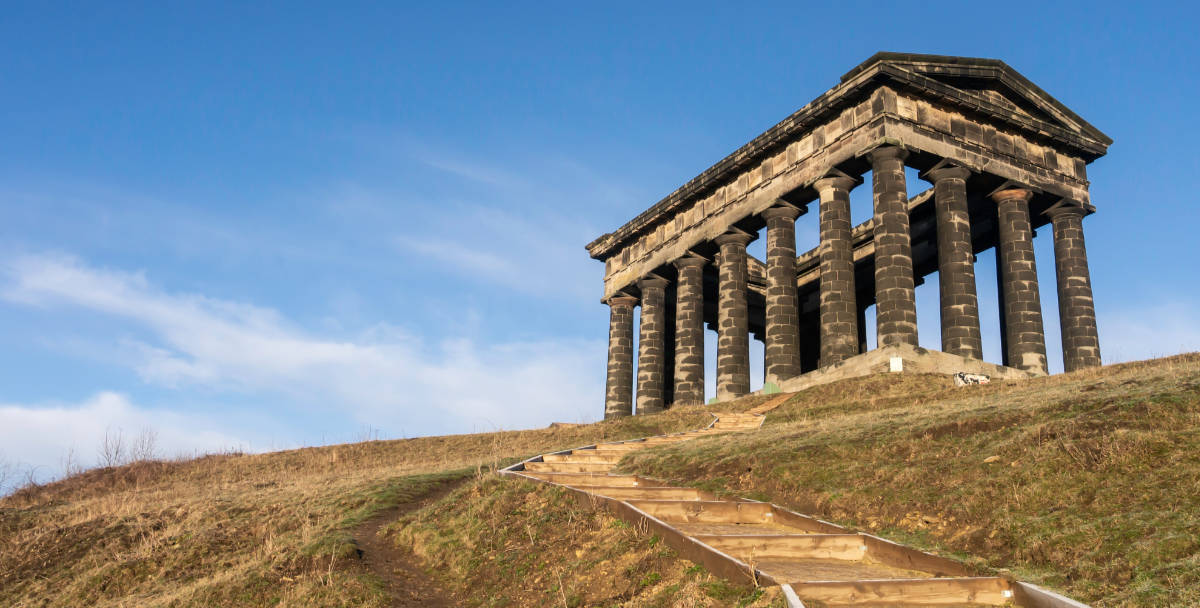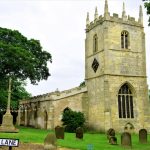
The best time to visit Houghton is in October when the famous Houghton Feast runs. The town has honoured the festival since the 1100s.
The charming Tyne & Wear town of Houghton-le-Spring can be found just east of Sunderland and offers a more relaxing alternative for the day tripper or staycationer. Best known for its long-lasting Octoberfest, but it has plenty going on at other times too!
It is one of a number of ‘le’ names in the area such as Hetton-le-Hole and Chester-le-Street. This harks back to its historic routes with the ‘le’ suffix coming from the Norman bishops who ruled after 1066. Thus it is steeped in history and has a lot more to offer than being ideal for commuters to Sunderland. Anyway, let’s check it out.
The Early History of Houghton-le-Spring
Like any good story, we have to start at the beginning for it to make sense. Back in the days before the Romans arrived here, tribes ran Britain. This far north you could expect to find the Brigantes tribe running the show. The Brigantes tribe owned the largest territory spanning most of the north of England, and some of the middle countries, too.
They were mighty, ruling coast to coast over the kingdom of Brigantia – later to form Yorkshire. The northern border was actually the River Tyne, where they neighboured the Votadini tribe of Northumbria.
When the Romans came, they fought their way north, either negotiating with or eliminating the tribes. When they got to the northern border, they saw the problem of the Scots, and Hadrian slapped a wall up. Later expansion into the north took place, but we at least know that the Romans were in this area.
We also know they were prolific to the north in Wallsend, which would make this whole area prime territory for villas, stables, bathhouses, and inns. Roman coins uncovered throughout the area prove that it was a reasonably busy thoroughfare.
The Romans retreated in the fourth century, leaving behind semi-abandoned settlements all over the place. For a while, Angles and Saxons mingled across the land, building farms and little village settlements. The 1311 Sir Henry Spring’s widow owned the town. The feast festival held for 10 days every October dates to this era.
Medieval Times in Sunderland
The area isn’t mentioned in the Domesday Survey however as far as we know Houghton’s first mention comes from a text written by the Bishops of Durham circa 1183. It records the town as fairly well-developed already. Houghton-le-Spring in the 1100s had a smithy, a carpenter, a punder (who we used to need to capture wild animals), two mills, and a whole bunch of sheep. The accounting by the Bishopric of Durham is the most accurate we have.
Around the same time, the Springs family became a prominent name in the town. There is debate over whether the -le-Springs part of the name comes from a spring in a nearby hillside, of from this prominent family. The Springs part was added to distinguish it from several Houghton towns up and down the country. Houghton comes from Old English and means a town on a hill.
During Norman times, the Parish church of St Michael and All Angels first opened. To this day it contains the tomb of one of the former Archdeacons. He was rector in 1557. At that time, the parish of Houghton-le-Spring was one of the largest in England.
Medicinal Properties
In 1598, parish records report a spring found in the area had medicinal properties. The spring is in the nearby hills which is made of limestone rocks. There was once an area of the town known for holding a small lake, which was diverted long ago. In 1574 Kepier Hall opened to the north of town and would later house a school which was run by Rector Bernard Gilpin. His rectory was near Houghton Cut and was embattled after 1483. It had extensive work in the 1560s, 1660s, and 1790s.
At some point in history and nobody is really sure when the Houghton Cut was formed. The Cut describes how Houghton-le-Spring is cut into the hillside. The cut runs high through the hills, and now supports the A690.
That’s a fair start on the history of the town. Houghton was a prominent coal mining settlement but more on that in a moment. Let’s pause to review some fun facts we found out about Houghton-le-Springs.
Trivia About Town
Here are a few interesting (well fairly interesting) Houghton-le-Spring facts:
- The town is famed for the Houghton Feast. The celebration lasts for a full ten days commencing on the 12th There are fairground rides, stalls, fireworks, and other general revelries.
- Mining was the main industry here for over 150 years. The main shaft in Houghton-le-Spring opened for business in 1823 and didn’t close until 1981. Ask your northern parents and grandparents about the miner’s strikes and the closure of the mines in the 80s under Thatcherism. It dropped some of the north into poverty which took decades to recover from.
- Houghton-le-Spring marks the halfway point between Durham and Sunderland. This adds to the evidence that Romans would pass through here often, perhaps explaining the Roman remains and coins found in the area.
- Houghton Hall opened in 1589 after the building began in 1575.
- The town made international headlines in 2021 when ten teens aged between 14 and 17 attacked and killed the eleventh teen. The teen was walking home from the October Houghton Feast when he was assaulted by members of the gang wielding a machete-style knife. The community is still reeling from this awful blow to its youth.
- You can still visit St Michael and All Angels church, which remains in the same spot that it began in, back in the Saxon period. It possibly stood upon an older structure. The Black Douglas sacked the church, of Clan Douglas (whose castle was nicknamed ‘Castle Danger’), in 1319.
Armed with these local trivia titbits, you should pass as someone familiar with the area, if not as a local quite yet. Let’s learn some more history about the town and then you qualify to pass the “tourist” test.
The Industrial Era in Tyne and Wear
The industrial period kicked off in 1668 in Houghton-le-Spring when a prominent merchant from Sunderland named George Lilburne funded the local alms-houses. These were buildings to shelter local vagrants and give to the needy. They were the medieval/industrial period version of a food bank. Some had rooms to keep people off the streets in the worst weather.
In 1815 the British brought soldiers captured from the Napoleonic Wars into Houghton. They made them manually deepened the Houghton Cut by hand. The blasting process made the road better, improving trade with the nearby cities. It was then that the industrial era could truly take hold.
The town had its own brewers in the 1870s. Mining and beer drinking went hand in hand. It was tough work down in the pits. The brewery has long since seen conversion into apartment buildings. In the 1860’s Sir George Elliot was a businessman who began working in the mines at a young age.
He worked his way upwards to become the owner of Houghton Hall. He died in 1860 as a local legend. His daughter was getting ready for a party in the house one night a year later when her dress caught fire. She also died on the property. The hall belonged to the 160th Brigade Royal Field Artillery in 1915. There are several reported ghosts active in the hall culminating from all this activity.
Cholera Strikes
A cholera outbreak in the 1850s saw the quarriers take a cut of the limestone and use it to bury bodies. There were so many deaths that the churchyards were full and there were not enough people to move the bodies. The Rector Reverend John Grey consecrated one of the old quarries. The townsfolk objected with many workers saying they didn’t want to be buried in the quarries they spent their lives working. However, the situation was dire and the Reverend persisted.
The quarry went ahead in 1854 and the town extended it in 1894. One of the key protestors against the quarry graves was a man named Robinson. His family went on to open the brewery. It finally closed in 1926.
Although mining was a huge industry in the town, there were still problems with it. Mining was not a safe industry and regularly saw incidents and deaths. In this area of the country, there were problems with underground gas pockets. Towns in Tyne & Wear suffered terrible losses in providing the rest of the country with coal. An 1828 Houghton-le-Spring mining accident saw three men and four boys die in the mine, which belonged to Lord Durham at the time.
Modern Day Houghton-le-Spring
The Houghton-le-Spring Cenotaph, unveiled in 1925, commemorates the victims of the World Wars. Houghton war memorial contains 236 individual names and commemorates several wars. You can find it in St Michael’s churchyard, where the Earl of Durham unveiled it. It is 18.5 feet tall and is made of Portland Stone.
Excavations in 2009, while the church of St Michael was undergoing refurbishment, found evidence of the remains of a Roman settlement. This makes sense since Sunderland is nearby and their wall was not so far to the north.
When the pits closed in the ’80s the town descended into a deeper level of unemployment. Retail businesses have soaked some of the overspill, with the town gradually evolving from a mining town to a commuting town. Much of the area has been rewilded now, giving new life to a formerly industrialised landscape. Is Houghton-le-Spring a lovely place to visit? Sure. It’s even a lovely place to raise your kids.
Famous People from Houghton
Any given town in England has at least three celebrities. Even far-flung, remote villages in the hills have at least one claim to fame. We researched the most famous people from in Houghton-le-Spring and here is what we dredged up:
- Mary Ann Cotton – the first ever female serial killer in Britain – came from Houghton-le-Spring. She lived there with her family after the deaths of three of her four husbands and 11 of her 13 children. She was only caught for her final crime. She attempted to poison her stepson after failing to get him sent away to boarding school. The boy died and investigators finally noticed the many, many family deaths in her life. They found arsenic in the kid’s body. When they hanged her, they set the rope too short. Her neck did not snap and she suffocated instead. Speculation suggests this was a deliberate ‘mistake’.
- Then there’s Charlotte Crosby from Geordie Shore, a show which kills people in other ways.
- Michael Adams, who presented on CBBC
- Bernard Gilpin, the Apostle of the North, was a famous Houghton-le-Spring resident. He was an Archdeacon of Durham and was the rector from 1557.
- Novelist Sheila Quigley is from here
- And a few footballers, including David Knight, Chris Penman, and Trevor Swinburne.
Now that we have covered all the bases, we can review the best attractions in town.
The Best Attraction in Houghton-le-Spring
This is the section of the article that everyone has been waiting for – when you get to learn what the best things to see and do in Houghton-le-Spring are. Whether you are here for a few weeks or just passing through, here are the sites you ought to see.
Historic sites
Remember earlier when we mentioned that the townsfolk had so many cholera deaths that the reverend consecrated an old quarry? You can still visit the Houghton Hillside Graveyard and see this remarkable site for yourself. What’s even more remarkable is the view. It’s a peaceful place to meet your final rest.
You could stop by the church, St Michael and All Angels, to see the oldest building in town. The church dates back to Norman times although extensive work has changed it over the years. The church bills itself as the heart of the community for over a thousand years. That’s an unbeatable record. You can still catch a service – or even get married there – today.
Landmarks

mage: LouieLea/Shutterstock.com
The Penshaw Monument built-in 1844 dominates the nearby hilltop and you can see it for miles around. It is a bit of a trek on foot but worth the journey especially if you have the car with you. It is a recreation of the Temple of Hephaestus in Athens and stands 70 feet high on top of the hill, inside its own public park. Go along, take the hike, stand inside it and feel like you are tiny. It will be worth it.
Cultural attractions
There are no museums in Houghton-le-Spring. If you want to amuse the kids with some educational exhibitions though, head to the Sunderland Museum and Winter Gardens in the off-season, or the Durham Museum and Heritage Centre year-round. Both places will teach you about the tribulations of the Tyne & Wear people over the years. Except one does it with a pretty garden attached.
If you’d like to see some free art installations, jump to Elba Park and see the banner artworks in the park. Otherwise, you can visit the Jungleman art gallery in town to get stuck into some creative projects of your own.
Outdoor attractions
If you enjoy nature, get out to the reeds and natural marsh habitats found in Rainton Meadows. See the wildflowers and chase dragonflies the size of your face. Enjoy a family day out courtesy of the Durham Wildlife Trust. You may run into the odd school group or birdwatcher. It’s a calming place removed from the town.
If you are staying in Houghton-le-Spring in summer and you want to enjoy the great outdoors, you will find 53 acres in Elba Park. There is a small woodland, a meadow, and plenty of places to play with your new birthday toys, in the park. There are some art installations to admire, too. The space belongs to the Land Trust, which runs a network of similar parks throughout England and Wales.
Sports and Recreation
Although Houghton-le-Spring doesn’t have a football club which represents the town, there is a local Rugby Union Club, instead. The town has had a juniors team, the Hetton Juniors, since 1996.
Houghton has its own golf club; you will be happy to hear. Houghton-le-Spring Golf Club opened in 1908 and is still teeing up today. Go along to play for a day as a guest or pay your green fees and sign yourself up for the whole 18 holes. The course is 72 par. We assume that means it’s hard.
Shopping in Houghton
You can do your everyday supplies shopping in Thornhill St. However, you are not far from either Durham or Sunderland if you want to go shopping in the big city. If you need a temporary fix for a Saturday afternoon out of the house, check out the Hylton Riverside Retail Park. It’s closer to Sunderland but worth the trip.
Where to eat and drink in Houghton-le-Spring?
Houghton has some great takeaway restaurants. The top-rated places to eat in town include the Amalfi Ristorante Italian place and the StackYard. The Italian Farmhouse in West Rainton have an interesting take on country-style Italian food. You can always get a pint and usually a pie at the Stables Pub & Eatery. If you want a fun night out try the Beehive or Tropi’s Bar.
What to do with kids?
Down at the Farm is just outside of town and it allows the kids to get back to basics with the countryside. There is an epic adventure play park here, plus lots of little animals they can meet. The animal fun park includes optional extras for additional fees. Sometimes they might do tractor rides, or feeding baby animals, or pumpkin picking. Check what is on through their website before you go.
Other Notable Nearby Attractions in Tyne & Wear
There are lots of other great places to see with excellent attractions of their own all over Tyne & Wear. You should check out the following places if you are taking a holiday in the north, or if you are moving here:
- Head to Wallsend to see the end of Hadrian’s Wall.
- Go to Hebburn or Cramlington and learn even more about the history of mining in Tyne & Wear.
- Find out where George Washington’s family came from in nearby Washington.
- Head to Tynemouth to see the Spanish Garrison.
- Spend a nice day at the beach in Whitley Bay.
- Or go shopping in Newcastle or Sunderland
There is something to do for everyone in this area, and for all ages. Get out there and explore. You can never have enough experiences.
How to get to Houghton-le-Spring?
In this section, we fill you in on how to get there. We have to be honest about this. If there were two door handles giving you directions and only one of them could tell the truth, we would bet on the other guy. Here goes nothing.
By Road
If you follow the A690 south and east out of Sunderland you will reach Houghton.
Rail
Sorry, no train station. However, there is a bus station.
By Air
The nearest airport is Newcastle International.
By Sea
You are landlocked in Houghton but not too from the coast.
Got Five Minutes?
If you are still investigating the best places to visit in Britain and you need more inspiration, our travel guides will help. You can browse them on our website or you can hop over to Facebook and show your support by giving us a follow. We are easy to please. Hope to see you there.




